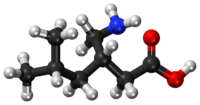
Photo from wikipedia
Abstract The encapsulation of molecules of therapeutic interest is emerging as an attractive tool to increase the stability of an active ingredient, to control its release over time and to… Click to show full abstract
Abstract The encapsulation of molecules of therapeutic interest is emerging as an attractive tool to increase the stability of an active ingredient, to control its release over time and to prevent drug overdose. In this drug delivery approach, several analgesic molecules are considered, including (2E)–2-cyano-3-(furan-3-yl)acrylic acid (CFAA), and the host structure, lamellar double hydroxides (LDH) of the hydrotalcite type, as a vector. These organic compounds are prepared by Knoevenagel condensation between cyanoacetic acid and an aldehyde. Two strategies were employed: direct insertion of the organic compounds by ion exchange versus in situ 2D confinement by Knoevenagel condensation from LDH organo-modified with cyanoacetic acid. The physicochemical characterization (XRD and SS-MAS-NMR) of the hybrid organic/inorganic complexes allows comparison of the two approaches and their release properties complete the study.
Journal Title: Journal of Solid State Chemistry
Year Published: 2018
Link to full text (if available)
Share on Social Media: Sign Up to like & get
recommendations!